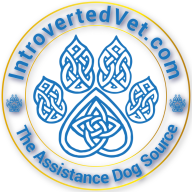Abhean submitted a new resource:
SDiT Manners/Evaluation - This evaluation is intended as a tool to help mark progress along a service dog training journey.
It is important that throughout their experience in these types of environments, the dog is generally comfortable with the situation. The dog should not have a baseline nervousness or high stress level, as the dog might indicate by showing ongoing stress signs. It is okay to show moderate stress where it is normal for the situation, but a quick recovery is key. A dog that is either generally uncomfortable or particularly stressed in situations described in this document may need to be desensitized through further training before passing this evaluation.
Any dog going out to no-pet places should be fully housetrained. Even so, it may be advisable to carry clean-up supplies, just in case the dog has an accident.
The public places its trust in service dogs not to be dangerous. It is fundamental that the dog not exhibit aggression, such as growling, nipping/biting, showing/baring teeth, or lunging in an attacking manner. The dog also should not cause significant disturbances, such as through inappropriate, excessive barking, or by quickly lunging or moving in ways that are unpredictable and possibly frightening or dangerous to others.
A dog's needs for basic care must be met if it is to work as a service dog. example, the dog should be sufficiently bathed and groomed so that it does not produce offensive smells or excessive shedding (to an extreme degree that would be noticeable and similarly inappropriate in humans). Perfuming the dog is not advised. The dog should also not have or exhibit an obvious medical problem that requires treatment, such as a painful limp, emaciation, or uncontrolled parasites, that may interfere with the ability to comfortably work or safely be around others.
Handlers should not need to lure a dog through a behavior for this evaluation. "Luring" a dog through a behavior is when the dog appears to execute the desired behavior, but only does so by closely following a treat, a leading hand (different from small hand signals), etc. Luring may assist in teaching a behavior, but does not show a dog understands the behavior and cue, so luring does not demonstrate proficiency.
Once a dog entirely completes an individual behavior in this evaluation without luring (according to the tester), the test-taker is welcome to offer treats, a toy, or other rewards as appropriate. Reward timing exceptions are noted in activity descriptions. The frequency, variety, and types of rewards should match the individual dog's likes, needs, and progress. Advancing in training should correspond with using fewer rewards or fading them out completely, as long as the dog's performance is reliable without them.
Aversive training methods (such as strong leash corrections) should not be used. Especially before a dog graduates as a service dog, the dog should be rewarded in a way that fosters the dog's desire to work as part of a team.
With a service dog in training, it is key that the handler pay attention to the dog to catch desired and undesired behaviors and train appropriately. Early on in training, it is not a time to concentrate on shopping, reading labels, or even purchasing anything. The handler should be engaged with the dog, such as by providing feedback/rewards to motivate the dog, rather than ignoring the dog and letting the dog wander.
Activities
Waiting calmly
Attention cue
The dog should be able to respond to the handler with attention on cue. This could be a "watch" or "look" cue, a "touch" cue, or even the dog's name, if trained to focus on the handler when their name is said.
Startle recovery
The tester should drop a metal bowl, car keys, clipboard, or some other noisy object on the ground approximately 5–10 feet from the dog. The dog can startle and safely, nonaggressively break position when this happens, as long as the recovery is fairly quick and the dog is able to pay attention to the handler.
Working position
The tester will instruct the team on a short path to walk (at least 50 feet) to demonstrate the team's default working position in public. The dog should be able to walk around generally in heel position or in another working position the team uses, which can vary based on what the team needs or prefers. No strong leash corrections are allowed. If a leash is used, it should generally be loose (with a "J" in the leash); there should be little or no straining against a leash or harness unless it is reasonably needed for disabilityrelated work at the time. It is acceptable to briefly give one or two treats as rewards during this activity, but not as lures to stay in working position
Basic obedience
Supervised separation
Even for the most attached service dog teams, unpredictable emergencies happen and teams may have to be separated for a time. To begin preparing for such unusual or other everyday occurrences, the dog should be able to be left with another person while the handler exits the room and remains out of contact. The dog should stay with the alternate handler for approximately 30 seconds. The dog can reposition, move, and make some quiet noise, but the dog should neither bark at full volume nor completely lose control due to the distance of the handler. The alternate handler is not required to be an inanimate post; casually talking to or petting the dog a little is okay. Actively trying to keep the dog distracted is not okay, as this would not be an appropriate simulation.
Working around other dogs
Walking through doorway
Controlled vehicle entry and egress
Friendly stranger
Comfort with stores
Read more about this resource...
SDiT Manners/Evaluation - This evaluation is intended as a tool to help mark progress along a service dog training journey.
From PSYCHIATRIC SERVICE DOG PARTNERS
This evaluation is intended as a tool to help mark progress along a service dog training journey. This journey has many gray areas in the transition from pet-friendly environments to no-pet places. Accordingly, this guide alone should not be misinterpreted as a black-or-white stamp of approval or disapproval. However, a dog's ability to fairly proficiently execute these behaviors is a good indicator that the dog is ready to start training in no-pet...
It is important that throughout their experience in these types of environments, the dog is generally comfortable with the situation. The dog should not have a baseline nervousness or high stress level, as the dog might indicate by showing ongoing stress signs. It is okay to show moderate stress where it is normal for the situation, but a quick recovery is key. A dog that is either generally uncomfortable or particularly stressed in situations described in this document may need to be desensitized through further training before passing this evaluation.
Any dog going out to no-pet places should be fully housetrained. Even so, it may be advisable to carry clean-up supplies, just in case the dog has an accident.
The public places its trust in service dogs not to be dangerous. It is fundamental that the dog not exhibit aggression, such as growling, nipping/biting, showing/baring teeth, or lunging in an attacking manner. The dog also should not cause significant disturbances, such as through inappropriate, excessive barking, or by quickly lunging or moving in ways that are unpredictable and possibly frightening or dangerous to others.
A dog's needs for basic care must be met if it is to work as a service dog. example, the dog should be sufficiently bathed and groomed so that it does not produce offensive smells or excessive shedding (to an extreme degree that would be noticeable and similarly inappropriate in humans). Perfuming the dog is not advised. The dog should also not have or exhibit an obvious medical problem that requires treatment, such as a painful limp, emaciation, or uncontrolled parasites, that may interfere with the ability to comfortably work or safely be around others.
Handlers should not need to lure a dog through a behavior for this evaluation. "Luring" a dog through a behavior is when the dog appears to execute the desired behavior, but only does so by closely following a treat, a leading hand (different from small hand signals), etc. Luring may assist in teaching a behavior, but does not show a dog understands the behavior and cue, so luring does not demonstrate proficiency.
Once a dog entirely completes an individual behavior in this evaluation without luring (according to the tester), the test-taker is welcome to offer treats, a toy, or other rewards as appropriate. Reward timing exceptions are noted in activity descriptions. The frequency, variety, and types of rewards should match the individual dog's likes, needs, and progress. Advancing in training should correspond with using fewer rewards or fading them out completely, as long as the dog's performance is reliable without them.
Aversive training methods (such as strong leash corrections) should not be used. Especially before a dog graduates as a service dog, the dog should be rewarded in a way that fosters the dog's desire to work as part of a team.
With a service dog in training, it is key that the handler pay attention to the dog to catch desired and undesired behaviors and train appropriately. Early on in training, it is not a time to concentrate on shopping, reading labels, or even purchasing anything. The handler should be engaged with the dog, such as by providing feedback/rewards to motivate the dog, rather than ignoring the dog and letting the dog wander.
Activities
Waiting calmly
Attention cue
The dog should be able to respond to the handler with attention on cue. This could be a "watch" or "look" cue, a "touch" cue, or even the dog's name, if trained to focus on the handler when their name is said.
Startle recovery
The tester should drop a metal bowl, car keys, clipboard, or some other noisy object on the ground approximately 5–10 feet from the dog. The dog can startle and safely, nonaggressively break position when this happens, as long as the recovery is fairly quick and the dog is able to pay attention to the handler.
Working position
The tester will instruct the team on a short path to walk (at least 50 feet) to demonstrate the team's default working position in public. The dog should be able to walk around generally in heel position or in another working position the team uses, which can vary based on what the team needs or prefers. No strong leash corrections are allowed. If a leash is used, it should generally be loose (with a "J" in the leash); there should be little or no straining against a leash or harness unless it is reasonably needed for disabilityrelated work at the time. It is acceptable to briefly give one or two treats as rewards during this activity, but not as lures to stay in working position
Basic obedience
Supervised separation
Even for the most attached service dog teams, unpredictable emergencies happen and teams may have to be separated for a time. To begin preparing for such unusual or other everyday occurrences, the dog should be able to be left with another person while the handler exits the room and remains out of contact. The dog should stay with the alternate handler for approximately 30 seconds. The dog can reposition, move, and make some quiet noise, but the dog should neither bark at full volume nor completely lose control due to the distance of the handler. The alternate handler is not required to be an inanimate post; casually talking to or petting the dog a little is okay. Actively trying to keep the dog distracted is not okay, as this would not be an appropriate simulation.
Working around other dogs
Walking through doorway
Controlled vehicle entry and egress
Friendly stranger
Comfort with stores
Read more about this resource...
Attachments
Last edited:











